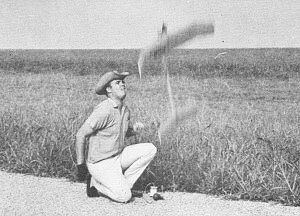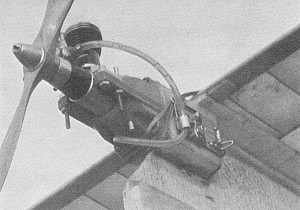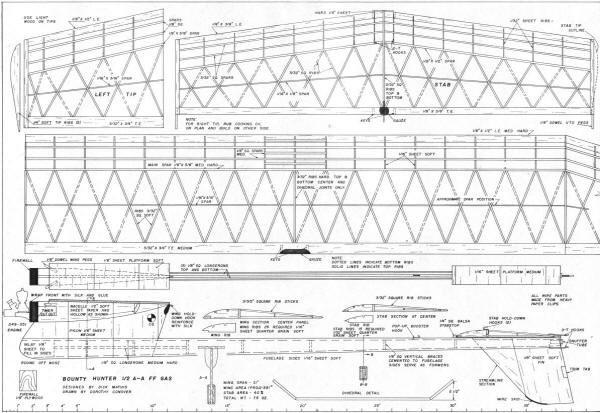|
Airplanes and Rockets
website visitor Mel G. wrote to ask that I scan and post this article on Dick Mathis'
famous Bounty Hunter 1/2A free flight airplane. It appeared in the September/October
1965 issue of American Modeler magazine. Mel says he built one from a kit
bought at
MAL Hobby
(Model Aircraft Laboratories) back in the 1980s. According to their website MAL
Hobby has been in business in Irving, Texas, since 1948, but according to Archive.org
their website appears to have disappeared sometime about 2014. I could not find
the Bounty Hunter kit listed on their website. If you are looking for an article
or plans not already posted here, please send me an e-mail and I will be glad to
do so if I happen to have the issue you need.
Bounty Hunter
 by Dick Mathis by Dick Mathis
Likes hot 049 or 051 size powerplant; VTO's with a passion; designed to take
advantage of latest advances in model engineering and to fit the new short-run rules.
Over 50 already tested in contest warfare!
Working toward a PhD degree, Bounty Hunter designer Dick Mathis teaches freshman
sociology at the University of Texas. Credits the East Dallas Exchange Club, sponsors
of the Southwest Championships, and Maurice Teter, noted Exchangite and long-time
air-model leader, with helping him along, not only in modeling, but in his, college
career.
This ship lives up to its name. It does everything but accept the trophies. It's
no one-man design either, since many others are winning with it in sizes up to 1,000
square inches and all over the Southwest.
The "Bounty Hunter" is an unusual bird, but there are good reasons for its differences.
And, unlike most well-known designs, the reasons were considered before the first
ship was built, not afterward. It isn't just a re-designed version of an old standard.
 Dick releases the Bounty Hunter for another
great flight.

Cox .049 engine up front. Mechanical timer.
Have you ever considered when the "big" designs of today were first introduced?
The Starduster, the Ramrod and the Satellite were all conceived before 1959, which
is six years ago. That was before the unlimited weight rules, before the super-hot
Cox Tee Dee .049, before exotic fuels like K&B speed fuel and Wysong's "This-is-it"
were generally available, before pressure fuel feed became popular and before really
good "contest" balsa was accessible to everyone.
These are big changes and it would appear that a new idea or two might take advantage
of the increased power, reliability and the potentially lighter weight. But, no!
It seems that everyone is content to stick with the same old stuff, or minor modifications,
and just see how much higher models will climb. If any manufacturer comes up with
a hotter engine we will be faced with re-entry problems.
There is a human, not aerodynamic limit beyond which altitude in the climb hurts
rather than helps. A hot Starduster got so high in nineteen seconds that a good
thermal could take it out of sight in less than three minutes. The timer isn't the
only one who can't see it. What about the frantic retriever chasing a speck overhead?
To avoid this problem, many excellent flyers purposely cut their motor runs short.
(New rules enforce the short run.) Would you fight Zorro with your X-Acto knife
if you had an axe at your disposal? That's what these guys were doing.
Why don't we put some of that excess climb into a better glide? The two best
ways would be to use higher aspect ratios and high lift-drag airfoils or to use
more wing area. Of the two choices, the latter is preferable since it makes the
whole thing easier to see. Also, there seems to be more possibilities for a fine
glide in reducing the wing loading (weight divided by area equals wing loading)
and the only practical way to reduce wing loading now is to build bigger ships.
This is easy to see, since we have about three ounces of "inert" weight consisting
of the engine, prop, tank, timer, screws, hooks, fuse rubber bands, fuel and the
fuel tubing. This weight we can't easily reduce. If we build a 200 square-inch ship
that weighs 2-oz. without the hardware it will total in at 5-oz. But a 400 square-inch
ship that weighs 4-oz. will only total 7-oz. We all know it's easier to save weight
when the area goes up and still have strength. Anyway, it boils down to this: a
100 percent more wing area in the ship, but only 40 percent more weight using the
same construction!
Enough for the past, the Bounty Hunter is a "new breed", "people engineered"
design that uses effectively all the newest developments in the hobby industry.
Its wing is 391 square-inches projected. The stab area is 40 percent of the wing.
Weight comes in usually between 7 and 8-oz ready to launch. The airfoils are thin
by today's standards, being 8 and 6 percent for the wing and stab respectively.
The sections are not "Lindy" but from the 1958 Zaic Yearbook by Curtis Stevens.
The swept wingtips are in line with Don Foote's theories on thermal hunting. The
high thrust line is for handling power consistently.
Over fifty Bounty Hunters have been built by others, including one nice one by
a ten-year-old. Much of the success of the design is due to comments and suggestions
from these people about modifications to improve flying and building. There is nothing
more difficult than designing a ship that will work well for others and that can
easily be built by others. The design has proven itself in this respect and I am
prouder of that than its tremendous list of contest wins.
Making a big ship light enough to really be hot and at the same time keeping
it strong enough to allow handling in high winds is a good task. The Bounty Hunter
is one design that won't wrap itself around your arm in high winds.
The secret is in attention to structural design. While the birdcage construction
may look complicated, it is easiest and fastest according to those who have tried
it. I was prompted to use it first because I dislike cutting out ribs. It's supremely
light and really rigid. It works for all sizes, too.
Construction instructions are on Hobby Helpers' full size plans.
NOTE: Dick Mathis teaches freshman sociology at the University of Texas. Working
toward a PhD. Has BA in history from Arlington State College. Working this summer
at the University's Population Research Center. Has three year National Defense
Fellowship which will allow full effort studies. Wants to finish PhD in 1967, do
more college teaching, some research, eventually go into business as a consultant
in urban planning. Other hobby (apart from model airplanes) is tennis. Was high
school district champion at Arlington High for three years. Plays tournament tennis.
Dick says, "I owe a considerable debt of gratitude to the East Dallas Exchange Club
(sponsors of the Southwest Championships) for their financial aid throughout my
college career, and particularly to Maurice Teter, a leader in the club." Dick is
24 years old, single, a native Texan. Thinks modeling has had a very good influence
on his life. The Bounty Hunter is available in kit form. Send $4.95 plus .30 postage
to Model Aircraft Labs, 106 Lee Street, Irving, Texas. Full size plans are also
available as part of Group Plan #965 from Hobby Helpers, 1543 Stillwell Ave., New
York 61, N.Y. ($1.10).

<click for larger version>
Notice:
The AMA Plans Service offers a
full-size version of many of the plans show here at a very reasonable cost. They
will scale the plans any size for you. It is always best to buy printed plans because
my scanner versions often have distortions that can cause parts to fit poorly. Purchasing
plans also help to support the operation of the
Academy of Model Aeronautics - the #1
advocate for model aviation throughout the world. If the AMA no longer has this
plan on file, I will be glad to send you my higher resolution version.
Try my Scale Calculator for
Model Airplane Plans.
Posted October 14, 2022
(updated from original post
on 6/13/2012)
|